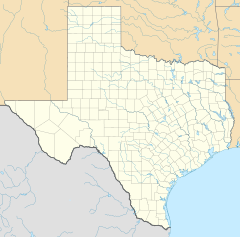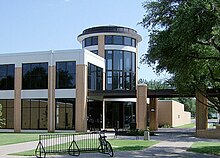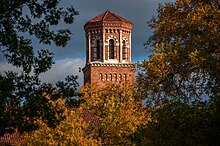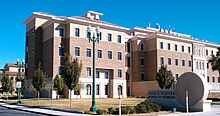Texas Tech University System
 | |
| Type | State university system |
|---|---|
| Established | 1996 |
| Endowment | US $1.28 billion (2020)[1] |
| Chancellor | Tedd L. Mitchell |
| Location | , , U.S. |
| Colors | Red and Black |
| Website | www |

The Texas Tech University System is a state university system in Texas consisting of five separate universities in the state of Texas, of which three are universities, Angelo State University, Midwestern State University and Texas Tech University, and two are health institutions, Texas Tech University Health Sciences Center and Texas Tech University Health Sciences Center El Paso. The system is headquartered in the Administration Building on the Texas Tech University campus in Lubbock, Texas.[2]
History[]
On February 10, 1923, Texas Technological College (now named Texas Tech University) was founded, and that August, a committee selected to locate the institution in Lubbock. The Board of Directors of Texas Technological College (now named the Board of Regents of the Texas Tech University System) was established to oversee the institution.
In 1969, the Texas Tech University School of Medicine (now named Texas Tech University Health Sciences Center), was founded as separate multi-campus institution from Texas Tech University. It was also overseen by same board of regents as Texas Tech University.
In 1985, then state senator, and future TTU System chancellor, John T. Montford proposed the creation of the Texas Tech University System.[3]
In 1999, the Texas Legislature formally established the Texas Tech University System, consisting of the same two institutions, overseen by the board of regents, and the newly created position of chancellor to provide leadership and support for both Texas Tech University, and Texas Tech University Health Sciences Center.
In 2007, Angelo State University left the Texas State University System and joined the Texas Tech System. On May 18, 2013, Texas Tech University Health Sciences Center at El Paso was established as a separate university in El Paso.
On August 6, 2020, the Texas Tech University System and Midwestern State University agreed to a memorandum of understanding to begin the process of MSU Texas becoming the fifth university to join the system.[4] The process was completed on June 8, 2021, when Governor Greg Abbott signed HB 1522 into law.[5]
Component institutions[]
Angelo State University[]
Angelo State University is a public, coeducational university located in San Angelo, Texas. It was founded in 1928 as a two-year college. In 1965, the school began offering four-year degrees and ten years later became part of the Texas State University System.
Angelo State University offers 97 bachelors, 23 masters, and 1 doctoral degree program. The university is divided into five colleges, Business, Education, Liberal and Fine Arts, Nursing and Allied Health, Sciences, and Graduate Studies.
In March 2007, Rep. Drew Darby and Sen. Robert Duncan co-sponsored House Bill 3564, which aimed to realign Angelo State with the Texas Tech University System.[6] The merger received widespread support in both Lubbock and San Angelo.[7][8] The bill was approved by the full House on April 24, 2007, and by the Senate in a unanimous vote on May 15, 2007.[9] On May 23, 2007, Gov. Rick Perry signed the bill.[10] A companion amendment to the Texas Constitution went before voters on November 6, 2007 as Proposition 1, which passed 66.28 percent in favor to 33.72 percent against.[11]
Midwestern State University[]
Midwestern State University is a public university in Wichita Falls, Texas. In 2015, it had over 6,000 students. It is the state's only public institution focused on the liberal arts.[12] The school was founded in 1922 as Wichita Falls Junior College and was renamed Hardin Junior College in 1937 when it moved to its present location off Taft Boulevard. In 1946, when a senior division was added, it was renamed Hardin College. In January 1950, the name changed to Midwestern University, with the junior college division remaining Hardin Junior College.[13]
Texas Tech University[]
Texas Tech University was founded in 1923, is a public, coeducational, doctoral/research university, and is the system flagship. Current enrollment totals 40,322 students. The main campus is located in Lubbock, Texas, and is bordered by Marsha Sharp Freeway (4th Street), 19th Street, University Avenue, and Quaker Avenue. It operates several satellite campuses and centers outside of Lubbock, listed in the next section. Texas Tech University consists of 11 colleges and offers 150 degree programs.
Texas Tech University Health Sciences Center[]
Texas Tech University Health Sciences Center was created as the Texas Tech University School of Medicine by the 61st Texas Legislature in 1969. In 1979, the charter was expanded to create the Texas Tech University Health Sciences Center. The university's enrollment was more than 4,000 as of Fall 2011. Texas Tech University Health Sciences Center is a seven-school university and operates five satellite campuses and academic sites in addition to the main campus in Lubbock, Texas.
Texas Tech University Health Sciences Center El Paso[]
On May 18, 2013, Texas Tech University Health Sciences Center El Paso (TTUHSC El Paso) was established as a separate university from TTUHSC. The university is made up of three schools: Gayle Greve Hunt School of Nursing, Paul L. Foster School of Medicine, and Graduate School of Biomedical Sciences.
Governance and administration[]
Board of Regents[]
The government, control, and direction of the Texas Tech University System is vested in a nine-member Board of Regents appointed by the governor and confirmed by the legislature. Each Regent serves a six-year term, and appointments are staggered so that three members of the Board's terms expire in odd-numbered years. In addition to the nine members, there also is a student regent who is appointed by the governor to serve a one-year term that begins on June 1 of each year.
In 1923, Governor Pat Neff appointed the first members of the Board of Directors of Texas Technological College (as the council was known until 1969). When the name of Texas Technological College was changed in 1969, so did the council to: Board of Regents of Texas Tech University.[14] The council has been known by its current name, Board of Regents of the Texas Tech University System, after the Texas Tech University System was established in 1996.
Chancellor[]
The Chancellor is the chief executive officer of the Texas Tech University System appointed by, and responsible to, the Board of Regents. The Chancellor carries out the policies of the System as determined by the Regents and has direct responsibility for all aspects of the operations of the Texas Tech University System's four primary components: Texas Tech University, Texas Tech University Health Sciences Center, Angelo State University and the Texas Tech University System Offices.
The Texas Tech University System has had five Chancellors: John T. Montford, David Smith, Kent Hance, Robert L. Duncan, and Tedd L. Mitchell.[15]
Presidents[]
The presidents of Texas Tech University, Texas Tech University Health Sciences Center, and Angelo State University are appointed by the Chancellor and are chief executive officers of their respective institutions and responsible for the strategic operation of each institution.
Campuses[]
The five institutions of the Texas Tech University System are located on multiple campuses and academic sites.
Angelo State University[]
Midwestern State University[]
Texas Tech University[]
- El Paso, Texas (College of Architecture branch)
- Escazú, San José, Costa Rica (Costa Rica campus)
- Fredericksburg, Texas
- Junction, Texas
- Lubbock, Texas (Main campus)
- Marble Falls, Texas (Texas Tech University at Highland Lakes)
- Seville, Spain
- Waco, Texas
Texas Tech University Health Sciences Center[]
- Abilene, Texas
- Amarillo, Texas
- Dallas, Texas
- Lubbock, Texas
- Midland, Texas
- Odessa, Texas
Texas Tech University Health Sciences Center El Paso[]
References[]
- ^ As of June 30, 2020. U.S. and Canadian Institutions Listed by Fiscal Year 2020 Endowment Market Value and Change in Endowment Market Value from FY19 to FY20 (Report). National Association of College and University Business Officers and TIAA. February 19, 2021. Retrieved February 19, 2021.
- ^ "Board of Regents Contact Information." Texas Tech University System. Retrieved on November 15, 2008.
- ^ "Questions emerge as signs point toward Tech systemBy MATTHEW HENRYAvalanche-". lubbockonline.com.
- ^ https://www.kcbd.com/2020/08/06/texas-tech-announces-mou-with-midwestern-state-university/
- ^ "Texas Tech University System welcomes Midwestern State University in Wichita Falls". Myhighplains.com. Retrieved 2021-06-17.
- ^ "Lawmaker Files Bill to Make Angelo State Part of Texas Tech System". KCBD.com. March 9, 2007.
- ^ "Help bring ASU into the Tech fold". Lubbock Avalanche-Journal. April 9, 2007. Archived from the original on September 27, 2007.
- ^ "A System switch spelled out - ASU realignment touted for various reasons". San Angelo Standard-Times. April 5, 2007. Archived from the original on April 10, 2007.
- ^ "Texas Tech and Angelo State Merger Sent to Governor Perry". KCBD.com. May 15, 2007.
- ^ "History for HB 3564". www.capitol.state.tx.us. May 23, 2007.
- ^ Gainesville Daily Register - 7 percent of Cooke County voters cast ballots Archived 2013-01-02 at archive.today
- ^ "MSU: Texas' only public liberal arts school". The Wichitan. 2016-06-22. Retrieved 2017-08-10.
- ^ "MSU History". Retrieved 2021-06-13.
- ^ Rushing & Nall Pg. 160
- ^ "Lobbyist to become Texas Tech University System chancellor". Houston Chronicle.
External links[]
| Wikimedia Commons has media related to Texas Tech University System. |
- Texas Tech University System
- Public universities and colleges in Texas
- Public university systems in the United States



